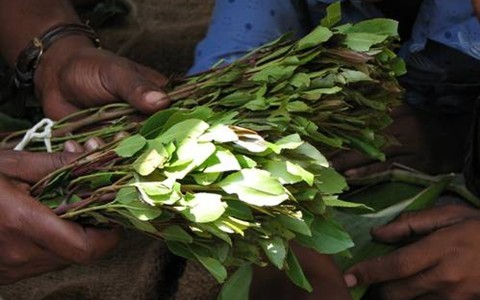
Where would the Ethiopian economy be without the mild, broadly illegal stimulant known as khat? Apparently in quite dire straits:
Coffee and khat exports earned Ethiopia close to 737 million dollars, which was 36.9pc of the total foreign exchange of two billion dollars that the country earned in the 2009/10 fiscal year with 36.5pc, 729.1 million dollars, coming from China.
Ethiopia’s foreign exchange income from exports for the year increased by 37.9pc to two billion dollars from last year’s 1.45 billion dollars, surpassing the 25pc the government had planned for.
Revenue generated by coffee and khat exports far exceeded that of last year, showing an increase of 40pc and 51.5pc respectively, while exports of leather and leather products plunged by 25.4pc.
There are several reasons that khat has become such a mainstay of the Ethiopian economy, starting with the strife in neighboring Somalia, which has undermined its capacity to export the drug. More important, the illegality of the trade bolsters prices, so that a small patch of khat can earn a farmer just as much as several acres of coffee. My quick back-of-the-envelope calculation, based on reported U.S. street prices and a very liberal markup estimate, reveals that a pound of Ethiopian khat allocated for export will wholesale for around $20. Compare that to current coffee prices, which are considered sky-high at $1.80 per pound.
These facts obviously give the Ethiopian authorities an incentive to look the other way regarding khat exports, despite the fact that much of the merchandise heads for markets where the drug is illegal. (Khat is legal to possess and chew in Ethiopia, though the government has recently tried to crack down on usage among motorists.)
The alacrity of shipment is key to the trade, because khat is a drug that loses potency quite quickly—so quickly, in fact, that it declines from a Schedule I drug to a Schedule IV drug in a matter of weeks after harvest. (See here for the complete DEA schedule tables.) That means that khat smugglers operate under extreme time pressure, especially once the goods are offloaded from ships or planes to ground transport. And yet khat keeps making inroads wherever East African migrants may roam—to the great delight of the Ethiopian treasury.


David Moles // Aug 4, 2010 at 3:44 pm
I kind of regret not trying it when offered on the minibus from Bahir Dar to Gonder. But I wasn’t sure a stimulant was the right way to go for a four-hour ride crammed with twenty other people in the back of a Toyota HiAce.
Brendan I. Koerner // Aug 4, 2010 at 4:04 pm
Agreed, you probably don’t want to be stimulated while hemmed into a confined space for a long stretch. Good call.
On the flip side, I wonder how global trade would be affected if illegal or quasi-legal stimulants like khat, yaa baa, etc. were less available. I don’t think it’s a stretch to assume that such drugs are integral to keeping long-haul truckers and other transport workers awake for long stretches. These drugs may be very deleterious to the health of individuals, but they also grease the global trade machine.
David Moles // Aug 5, 2010 at 2:30 pm
Good point. And coca in South America, I bet. Somebody needs to update Jim Croce’s “Speedball Tucker/” for the globalization era.